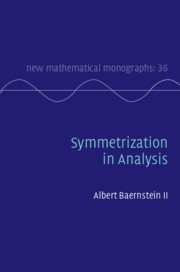Book contents
- Frontmatter
- Contents
- Notation
- Foreword
- Preface
- Introduction
- 1 Rearrangements
- 2 Main Inequalities on Rn3
- 3 Dirichlet Integral Inequalities
- 4 Geometric Isoperimetric and Sharp Sobolev Inequalities
- 5 Isoperimetric Inequalities for Physical Quantities
- 6 Steiner Symmetrization
- 7 Symmetrization on Spheres, and Hyperbolic and Gauss Spaces
- 8 Convolution and Beyond
- 9 The ⋆-Function
- 10 Comparison Principles for Semilinear Poisson PDEs
- 11 The ⋆-Function in Complex Analysis
- References
- Index
9 - The ⋆-Function
Published online by Cambridge University Press: 22 February 2019
- Frontmatter
- Contents
- Notation
- Foreword
- Preface
- Introduction
- 1 Rearrangements
- 2 Main Inequalities on Rn3
- 3 Dirichlet Integral Inequalities
- 4 Geometric Isoperimetric and Sharp Sobolev Inequalities
- 5 Isoperimetric Inequalities for Physical Quantities
- 6 Steiner Symmetrization
- 7 Symmetrization on Spheres, and Hyperbolic and Gauss Spaces
- 8 Convolution and Beyond
- 9 The ⋆-Function
- 10 Comparison Principles for Semilinear Poisson PDEs
- 11 The ⋆-Function in Complex Analysis
- References
- Index
Summary
This chapter marks the debut of the star function in the book. Each type of rearrangement has an associated star function, which is an indefinite integral of the rearranged function. This chapter proves ``subharmonicity'' theorems for the star function, expressing the fact that if a function satisfies a Poisson-type partial differential equation then its star function satisfies a related differential inequality. In the simplest case of circular symmetrization in the plane, the result says that if a function is subharmonic then so is its star function. Subharmonicity is applied in the succeeding chapters to yield comparison theorems for solutions of partial differential equations and extremal results in complex analysis.
Keywords
Information
- Type
- Chapter
- Information
- Symmetrization in Analysis , pp. 299 - 355Publisher: Cambridge University PressPrint publication year: 2019
